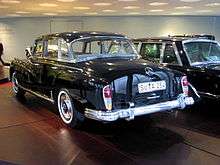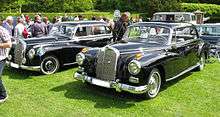Mercedes-Benz W189
The Mercedes-Benz W189 model 300 was a four-door luxury tourer produced by Mercedes-Benz between 1957 and 1962. It was the company's flagship model at the time, equivalent to the modern S-Class and Maybach.
 Mercedes-Benz 300 (W189) | |
| Overview | |
| Manufacturer | Mercedes-Benz |
| Also called | Mercedes-Benz 300d |
| Production | 1957-1962 W189 Saloon: 3,077 W189 Cabriolet D: 65 [1] |
| Body and chassis | |
| Class | Full-size luxury car |
| Body style | 4-door saloon 4-door phaeton 4-door cabriolet 4-door limousine |
| Layout | FR layout |
| Platform | Mercedes-Benz W189 |
| Related | Mercedes-Benz 300 Sc, Mercedes-Benz 300 SL |
| Powertrain | |
| Engine | 2996 cc M189 I6 |
| Transmission | 4-speed manual 3-speed automatic |
| Dimensions | |
| Wheelbase | W189: 3,150 mm (124 in) |
| Length | W189: 5,190 mm (204 in) |
| Width | W189: 1,860 mm (73 in) |
| Height | W189: 1,620 mm (64 in) |
| Curb weight | W189: 1,950 kg (4,300 lb) |
| Chronology | |
| Predecessor | Mercedes-Benz W186 |
| Successor | Mercedes-Benz 600 |
Marketed as the Type 300d,[2] it was equal in features and price but superior in performance to the rival Rolls-Royce Silver Cloud.[3] Favored by statesmen and business leaders, it offered options such as a glass partition, VHF mobile telephone, and dictation machine.
All but hand-built as the company flagship, the 300d is often identified as an Adenauer after Konrad Adenauer, the first chancellor of the Federal Republic of Germany, who employed six custom cabriolet, hardtop saloon, and landaulet versions of the W189 and its precursor W186 series during his 1949-1963 tenure. Among the custom features in these "parade cars" were writing desks, sirens, curtains, dividing partitions, sunroofs, and half-roof "landaulet" configurations.
Technologically advanced,[4] the fuel injected 3.0 L inline-6 "Type 300" was regarded as a "driver's" car, sharing numerous design innovations and mechanical components with the iconic Mercedes-Benz 300 SL "Gullwing", including engine, suspension, and chassis. It was succeeded by the 6 L W100 Mercedes-Benz 600 Grosser Mercedes in 1963.
300d
.jpg)

A successor to Mercedes' flagship W186 series final model, the 300c, the enlarged 300d (W189) was introduced in August 1957. Its new chassis code reflected sweeping refinements that included modernized bodywork, pioneering fuel injection, and a unique hardtop configuration transforming it into a pillarless phaeton.
Available as both a saloon and cabriolet, it retained the W186's proven X-frame chassis and was fitted with a more powerful version of its 3.0 L (2996 cc/182 in³) overhead cam, aluminum head M186 straight-6, the M189.
This shared improvements proven in the iconic 300SL "Gull Wing", the fastest production car of its day, including Bosch mechanical direct injection and an innovative diagonal head-to-block joint that allowed for oversized intake and exhaust valves. Output was an even horsepower per cubic inch, 180 PS (132 kW; 178 hp) at 5500 rpm.[5]
Designed to give reliable service under prolonged hard use, the engine featured deep water jackets, thermostatically controlled oil cooling, copper-lead bearings and a hardened crankshaft. A 3-speed Borg-Warner automatic transmission was standard. With no natural cruising speed, the car could sustain anything up to its maximum speed all day, road conditions permitting.[6]

The combination of a rigid X-shaped ovoid steel tube frame and four-wheel independent suspension provided surprisingly nimble handling. Double wishbones, coil springs, and a stabilizer bar were used up front, and Mercedes' typical double coil spring swing axle in rear. An innovative dashboard-operated rear load-leveling suspension engaged a torsion bar to increase stiffness by one-third when needed, and a pedal-operated central lubrication system kept friction points silent.[3] Brakes were vacuum-assisted hydraulic drum all around, steering recirculating ball. Power steering and Artic-Kar air-conditioning were new options.[5]
An additional 4 inches of wheelbase provided greater rear legroom, equaling that of the long wheelbase model Rolls-Royce Silver Cloud also introduced that year.[7] Removable rear quarter lights allowed an unobstructed view in and out from the front vent window on back, much valued in the model's popular role as a "parade car".
A total of 3,077 300d models (priced at DM 27,000) was produced through March 1962, along with 65 special-order 300d-based Cabriolet Ds (DM 35,500). After some overlap with the smaller, more contemporary styled W112 chassied 300SE that shared its engine, the 300d limousine was ultimately replaced as company flagship in 1963 by the 600 pullman "Grand Mercedes".
See also
References and sources
- Oswald, Werner (2001). Deutsche Autos 1945-1990, Band 4 (1st ed.). Stuttgart: Motorbuch Verlag. ISBN 3-613-02131-5.
- Sales brochure for the Mercedes-Benz Type 300d, storm.oldcarmanualproject.com Retrieved 23 August 2016
- Classic and Sportscar Magazine, February 1994, Pp. 52-55
- http://www.beverlyhillscarclub.com/buy-mercedes-benz-300.htm
- Jeff Miller (2002-03-02). "Mercedes-Benz Type 300 "Adenauer" limousine © www.mbzponton.org". Mbzponton.org. Retrieved 2010-10-01.
- "300 300b 300c 300d Convertible Sedan 1951-1962". Silverstarrestorations.com. Retrieved 2010-10-01.
- "Used cars on test: Rolls Royce Silver Cloud". Autocar. 126 nbr 3707: Pages 66–67. 2 March 1967.
- "300 S (W188)". Phil Seed's Virtual Car Museum. Retrieved December 1, 2005.
- "300 (W186, W189)". Phil Seed's Virtual Car Museum. Retrieved December 1, 2005.
- "Mercedes-Benz Type 300 Adenauer". MBZPonton.Org. Retrieved December 1, 2005.